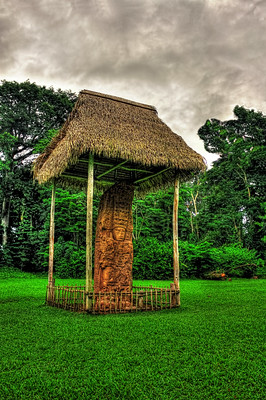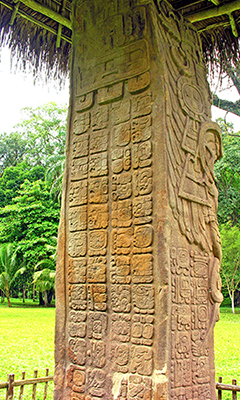Quirigua Stela J
Location: Quirigua, Northern Platform - Great Plaza
Dates: 9.16.5.0.0 / April 12, 756 CE
Ruler: 13
Measurements: 16.4 feet high, base 21.3 feet x 21.3 feet


Quirigua Stela J front and side
Left - Daniel M. Quiriguá GCA - Stela J, 2012, photograph. Flickr. Right - Dennis J. Guatemala-0612, 2007, photograph. Wikimedia Commons.
Quirigua’s Stela J was one of K’ahk’ Tiliw Chan Yopaat’s several monuments discussing the fall of Waxaklajuun Ubaah K’awiil. It was erected at the completion of the Northern Platform - evoking the entrance to the Underworld in the Great Plaza - the location where the thirteenth ruler was killed (Martin and Grube 2008, 221; Looper 2003, 82-83, 85). This particular stela’s dedication date would occur eighteen years after Waxaklajuun Ubaah K’awiil’s execution, allowing the city time to reap the benefits of their victory and develop their monumental program accordingly (Martin and Grube 2008, 205).
This stela is tall at 16.4 feet and is constructed in the wraparound style, defined as Type VI (Fash 2004, 259). Unlike previous wraparound stelae at Quirigua, Stela J contains side panels of text which are narratively more complex (Looper 2003, 101). On the wraparound, the king stands in shallow relief, wearing a headdress made of three masks topped with a bird god evocative of Tlaloc-Venus (Looper 2003, 107). In keeping with the ritual he wears heavy tinklers, knee bands, and a collar made from jade and shell. He wears a Sak - or Chaak - pectoral and a God C apron while surrounded by serpent heads (Looper 2003, 106). He has a Jaguar shield that may or may not depict the Jaguar Paddler God, complete with cruller (Looper 2003, 103). Interestingly, the possible god appears on the shield rather than out of the serpent bar like in Copan Stelae 7, P, and 2. Instead, staffs emerge from the serpent bar, similar to the more recent Copan Stela A (Looper 2003, 109).
In constructing the Northern Platform, K’ahk’ Tiliw Chan Yopaat presents himself as an incarnation of Chaak, a lightning and storm deity associated with fertility, agression, and more specifically execution (Stone and Zender 2011, 41). Chaak derived this association from his role in splitting the Maize mountain with his axe as well as a common depiction of him executing a jaguar. In doing so, K’ahk’ Tiliw Chan Yopaat cements his status as a warrior in a widely understood way (Looper 2003, 84). As a god of rainfall - necessary for all people, both king and commoner - Chaak was fairly universally worshipped (Stone and Zender 2011, 41).
This Chaak imagery continues on Quirigua Stela J, in which K’ahk’ Tiliw Chan Yopaat seizes k’awiil and wears a Chaak pectoral (Looper 2003, 103, 105). The text on the stela’s base also mentions the “Black Lake”, which both refers to the entrance to the Underworld as well as Chaak’s domain as executioner (Looper 2003, 83). The stela describes K’ahk’ Tiliw Chan Yopaat as kaloomte’, a title in times of war represented by Chaak with his axe (Looper 2003, 84). The Tlaloc-Venus headdress is also described as befitting a warrior (Looper 2003, 109).
Meanwhile, the pectoral represents the rebirth aspect of the deity and also functions as one of the three stones of creation along with k’awiil scepter and the jaguar shield (Looper 2003, 106). Chaak’s role of executioner when tied to splitting the mountain is also representative of rebirth as maize sprung from the cleft in the mountain (Stone and Zender 2011, 41). Likewise, the Paddler God’s represent the life death cycle in their duality and role as psychopomps, including for the Maize God (Stone and Zender 2011, 51).
Interestingly, in this stela, K’ahk’ Tiliw Chan Yopaat refers to himself with the succession glyph and the crossed bands glyph as the “Fourteenth Successor” (Schele 1986, 9). While the exact number of kings at Quirigua is unclear, this phenomenon is generally interpreted as the Quirigua king referring to himself as Waxaklajuun Ubaah K’awiil’s successor, putting himself in competition with actual Copan king K’ahk’ Joplaj Chan K’awiil and adding further insult (Looper 2003, 101). In using the crossed bands glyph, the Quirigua king even refers to the Foundation House at which Yax K’uk’ Mo’ both assumed the throne and oversaw Tok Casper’s - Quirigua’s first king - accession (Looper 2003 101; Martin and Grube 2008, 216). Similarly in this stela the Quirigua king refers to himself as having undergone ch’am-K’awiil, or taking K’awiil, on the day of the thirteenth Copan king’s death. While taking K’awiil usually refers to accession, here the term likely refers in part to the authority that Quirigua won from Copan (Stuart 2004, 233).
Yet, this stela also asserts Quirigua’s identity both as an emerging regional power and producer of its own monumental style. This stela at sixteen feet tall was a relatively early installment in a monumental program with stelae as tall as twenty-five feet, the highest in the region (Martin and Grube 2008, 221). With these impressive heights, Quirigua chose to abandon its former pattern of mimicking Copan stelae and return to its own Early Classic style (Martin and Grube 2008, 220-221). The wraparound design, shallow relief, squared shaft, blockiness, curved lines, and double outlines all work to revive and develop this style (Martin and Grube 2008, 221; Looper 2003, 110-112).
This stela understandably represents the rebirth of the city as a major power through physical prowess both in its content and the fact of its construction. The stela’s existence provides Quirigua with the physical authority to confirm its newfound power in trade and politics (Martin and Grube 2008, 221). Yet, its creation also petitions the divine in its ritual garb and the labor taken to create it, seeking the gods’ blessing in the city’s new role (Looper 2003, 114).
Motifs:
- Black Glyph in Skeletal Jaws
- Black Lake / Hole
- Centipede
- Chaak
- Creation Stones
- Crossed bands
- K'awiil
- Paddler Gods?
- Sak Pectoral
- Serpent Heads
- Skull with Vegetation
- Tlaloc-Venus
- Vision Serpent
See Also:
- Quirigua Altar L
- Hieroglyphic Stairway
- Stela A
- Quirigua Stela H
- Quirigua Stela D
- Quirigua Stela F
- Quirigua Stela E
- Quirigua Zoomorph G
Sources:
- Fash, Barbara W. 2004. “Early Classic Sculptural Development at Copan.” In Understanding Early Copan, edited by Ellen E. Bell, Marcello A. Canuto, & Robert J. Sharer, 249-264. Philadelphia: University of Pennsylvania Museum of Archaeology and Anthropology
- Looper, Matthew George. 2003. Lightning Warrior: Maya Art and Kingship at Quirigua. Austin: University of Texas Press.
- Martin, Simon and Nikolai Grube. 2008. Chronicle of the Maya Kings and Queens: Dynasties of the Ancient Maya. London: Thames and Hudson
- Schele, Linda. 1986. “Copan Note 8: The Founders of Lineages at Copan and Other Maya Sites” In Copan Notes, The, 1-21. Austin, TX: Copan Mosaic Project.
- Stone, Andrea and Marc Zender. 2011. Reading Maya Art: A Hieroglyphic Guide to Ancient Maya Painting and Sculpture. London: Thames and Hudson.
- Stuart, David. 2004. "The Beginnings of the Copan Dynasty: A Review of the Hieroglyphic and Historical Evidence" In Understanding Early Copan, edited by Ellen E. Bell, Marcello A. Canuto, & Robert J. Sharer, 215-248. Philadelphia: University of Pennsylvania Museum of Archaeology and Anthropology
Photographs:
- Quiriguá GCA - Stela J, by Daniel Mennerich, is licensed by CC-BY-NC-ND 2.0.
- Guatemala-0612, by Dennis Jarvis, is licensed by CC-by-SA 2.0.